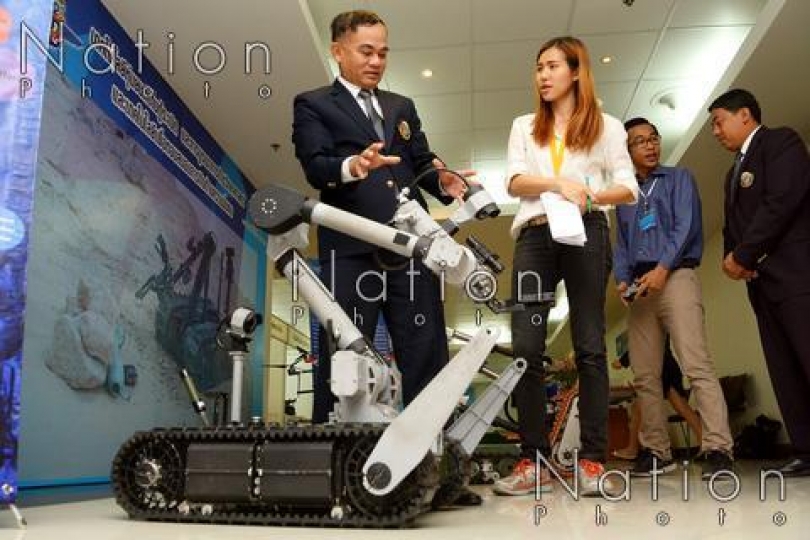Military chiefs call for more robots for national security

THE 26-kilogram, rectangular Portable Rescue Robot (PRR) stretched its manipulator arm, complete with a night vision camera, to surveil the area. With a wireless control system and two additional blades in front, the PRR showed off its ability to move fre
The display was performed in front of veteran military officers and weapons experts who met at a recent seminar on the development of military technology.
Mahanakorn University of Technology developed the robot, one of several robot prototypes that experts are collaboratively trying to develop to support national security missions.
Using robots, especially for bomb retrieval missions, has long been considered by the Thai military.
Over the recent decade, Thailand has seen both the Southern insurgency and terrorism plaguing national security, said Sqn Leader Jiradett Kerdsri, director of data and communication division of the Defence Technology Institute (DTI).
“While insurgency and explosions are ongoing in the South, the dreadful bombing in August last year at Ratchaprasong intersection, the heart of Bangkok city, also irked state security,” he said.
Such troubles affect the country’s tourism, economy and trustworthiness, Jiradett said.
“Foreign investors and tourists won’t risk coming to a hazardous territory,” he said.
It is essential, he added, for the DTI to select much-needed defence technology to be developed to serve the country’s security goals.
Inventing bomb retrieval robots is part of the DTI’s research plan initiated in 2009 to promote self-reliance in terms of national security and reduce the need to procure defence systems and equipment from other countries, said General Sompong Mukdaskul, DTI director-general.
Since its official establishment seven years ago, the DTI, under Ministry of Defence (MoD) oversight, has carried out five defence technology research plans focusing on rockets, unmanned aerial vehicles (UAVs), simulation technology, infantry fighting vehicles (IFVs), and military information and communication technology.
The DTI’s prototypes in each category have been distributed to the three branches of the Armed Forces – Army, Navy and Air Force – and the police.
When the DTI began supplying defence forces with equipment and systems, Sompong found that each user had different technology requirements. To meet those requirements, the DTI needed to listen to what users required before research began, he added.
“Collecting feedback and comments from military and police authorities is the DTI’s normal practice before and after each piece of defence equipment is unveiled,” the director-general said.
The PRR’s recent demonstration, and that of its robotic colleagues, in front of veteran officers and experts was part of that feedback process to fulfil the ambition to build sophisticated robots that can help to keep people safe in the field.
Air Force representatives told the seminar that the force needs robots that support remote operations with wireless and fibre optic control systems. The force has to patrol remote, inaccessible areas where land mines are a danger that could be mitigated by capable remote control robots, said Wing Commander Navin Vudhironnarith, deputy chief of the Air Force’s Explosive Ordnance Disposal (EOD) force.
The robots also need to be lightweight with fire-suppression systems, including recoilless water jets, for safety, he added.
The Army, on the other hand, needs user-friendly robots with very high capabilities, said Colonel Krittipas Cruanate, chief of the Army’s EOD.
“A single robot should not have all the functions. Some tasks do not need a full, heavy scanning system. Only reliable and enduring sensors and portable X-rays are necessary,” he said
The colonel, who has seen numerous officers and ordinary people killed in bombings in the Southern violence, said robots are necessary because they could help to reduce fatalities explosive disposal missions. “If we’d had high-tech robotics to carry out deadly missions, people and authorities would not have died,” he said.
To accomplish this new technological mission, participants agreed that academic institutions play a crucial role in developing new innovations because they act as centres of “know how” bringing together scholars and experts, Sompong said.
“Education institutions have performed tonnes of research but have no chance to apply their studies [in real situations],” he said.
The DTI director-general said he sees potential for knowledge transfers between these institutions and his agency.
“Their knowledge needs to be transferred and applied to the DTI’s work. By doing this, they have an opportunity to further develop their technology and it saves time for us to conduct research on the robots,” he said.
In addition to educational institutions, the industrial sector also has the potential to contribute to robotics projects.
To pioneer useful robots, industrial stakeholders need to get involved in terms of manufacturing, said Djitt Laowattana, lecturer at King Mongkut’s University of Technology Thon Buri and founder and director of the Institute of Field Robotics (FIBO).
Djitt said industry is important because of its expertise in effectively managing resources in manufacturing and, especially, marketing and distribution.
The DTI knows how to invent technology but does not specialise in managing resources and budgets, he said.
The government’s support is required to entice the public sector to become more involved in robotics development, he added.
The government should catalyse the industry by introducing a “local materials” requirement to promote companies to use components available in the country, rather than imported ones, Djitt said, adding companies that utilise local materials should get government incentives. That would encourage others to adopt more technology and robotic components made in Thailand, he said.
When robots are produced and sold on a large scale, the lecturer said, the robotics industry would increasingly grow, leading innovators and manufacturers to become eager to help to produce defence systems contributing to national security.
“I just hope that future robots answer the needs of defence suppliers. [We should] not just launch [the idea] and then put it on a shelf after our lengthy discussion today,” Sompong said. “And I just hope that the bomb retrieval robots will eventually be practical and meet international standards.”
RELATED
